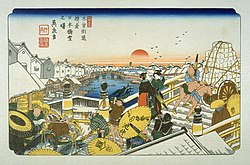Nihonbashi

Nihonbashi (日本橋, literally Japan Bridge), also romanized as Nihombashi, is a business district of Chūō in Tokyo, Japan. The district grew up around the bridge of the same name.[1] The bridge connects two sides of the Nihonbashi River. A series of bridges at the same site have had the same name since the 17th century.[1]
Traditionally, all distances in Japan are measured from the centerpoint of the Nihonbashi Bridge. This custom began in the Edo period.[2]
History

In the Edo period, the Nihonbashi Bridge was the start of Tōkaidō road which connected Edo and Kyoto.[3] The earliest Nihonbashi Bridge was made of wood. It was completed in 1603. The current bridge is made of stone. It was completed in 1911.[1]
In 2009, Nihonbashi was recognized as one of the 100 Landscapes of Japan which best show contemporary Japan and its culture in the Heisei period.[4]
Timeline
Nihonbashi Media
Ukiyo-e print of Nihonbashi by Keisai Eisen, c. 1836 (from The Sixty-Nine Stations of the Kiso Kaidō)
Nihonbashi Junior High School (中央区立日本橋中学校)
Kilometre zero is on the middle of the bridge.
Related pages
References
- ↑ 1.0 1.1 1.2 1.3 1.4 Chuo City Tourist Association, "Nihonbashi" Archived 2008-03-15 at the Wayback Machine. Retrieved 2012-3-25.
- ↑ Richie, Donald. (1994). Introducing Tokyo, p. 15.
- ↑ Nussbaum, Louis-Frédéric. (2005). "Tōkaidō" in Japan Encyclopedia, p. 973.
- ↑ "100 Landscapes of Heisei announced," Yomiuri Shimbun. May 2009. Retrieved 2012-3-30.
- ↑ Traganeou, Jilly. (2004). The Tokaido Road: Traveling and Representation in Edo and Meiji Japan, p. 230.
Other websites
![]() Media related to Nihonbashi, Tokyo at Wikimedia Commons
Media related to Nihonbashi, Tokyo at Wikimedia Commons
Coordinates: 35°41′02″N 139°46′28″E / 35.68389°N 139.77444°E






